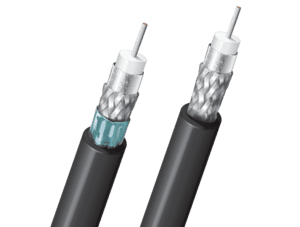The Sweeter Sound of Precision AV Interconnects
Precision interconnects help deliver the superb audio clarity and exciting video displays that make live events memorable, whether you have great seats or are following along at home.

It’s an incredible time to be a live music fan. After a long stretch of closed venues, thousands of musicians, comedians, and other live performers from across genres and eras are making up for lost time with busy touring schedules. If your favorite musician is still alive, there’s a good chance they are on stage this year. (And if they have passed on, augmented reality could enable them to join the band via hologram or video.)
Adoption of advanced audio and visual technologies accelerated during the early pandemic, when musicians perfected “live from home” concerts with exceptional sound and video clarity — enabled by precision AV interconnects — that the best seats may have been on your couch. In addition to new heights in sound and video quality, musicianship has become entwined with digital skills as electronic technologies such as accessible production software, affordable studio-quality microphones and recording equipment, and creativity tools such as loop pedals, which record a performance and play it back in real time, bring complex acoustic effects into their compositions and performance.

CDM Electronics’ microphone connectors feature chrome-plated machined brass shells and virgin resin phenolic. Superior contact design and construction provide exceptional signal integrity, which helps capture the spatial nuance and proximity effect of premium audio equipment. “Studio and live event connectors get dropped, handled, and plugged/unplugged repeatedly, so durability is a priority,” said producer Anthony Vezza, Right Coast Music. “Everything in a studio or on stage runs the risk of a malfunction, so allowing for a quick, easy, and solid repair is vital.”
Precision audio depends on a specialized subset of interconnects that can transfer power and sound quickly, without interference, distortion, or degradation of quality, to protect the clarity of the sound even at amplified volumes. Cables and connectors used in live performances link performers, microphones, speakers, instruments, recording equipment, lighting systems, and other stage and sound gear together. These interconnects must protect the equipment and performers from power surges and shock, especially in outdoor settings where weather is a factor. IP-rated components help protect connections from moisture or debris ingress. They must also be fast and easy to connect and disconnect, enabled by color-coding or keying, yet resist accidental disconnection through the implementation of a locking mechanism. Ruggedization is also required for long cables and equipment that vehicles and people could crush, trample, or jostle. Some sound designers favor gold-plated connectors for their ability to resist corrosion, which can distort signals, but both sides of the connection must be gold to preserve that effect. Nickel, bronze, and other alloys are also used. UV resistance is another important feature for connectors and cables used for outdoor events.
Common types of connectors used in live audio applications include ¼ inch TRS plugs (keyboards, amps, recording equipment), RCA connectors (turntables), 3.5 mm jacks (headphones), XLR connectors (speakers, audio interfaces, microphone cables), and MMCX connectors (mics). Balanced and unbalanced audio cables unite instruments and components. However, cables can pose a hazard on portable equipment such as microphones, so wireless connections have become popular, although interference, bandwidth limitations, and signal strength must be constantly monitored; wired connections still provide more reliability.
Producer Anthony “Vezz” Vezza considers interconnects to be a critical aspect of sound design. “I’ve seen cable failures happen in front of large live audiences. When using hundreds of cables at a time, cable failure can be catastrophic to a recording session or live production. Choosing the right cables with the right connectors for the right applications can make a huge difference in your career,” he said. Vezza specifies CDM microphone connectors for his installations because of their durability, ease of assembly, and quality. “Sometimes I’ll make a custom assembly and I might make a mistake. I need to know that I can quickly take it apart, resolder and put it back together without diminishing any quality in the connector. You also need something that can be used a thousand times and still be like the day you bought it.”

Belden’s 4K UHD Coax Cable, available from Mouser Electronics, for 12G-SDI supports 4K or UHD content without an overhaul to IP or fiber. It maintains a 12 GHz bandwidth and maximizes 4K/UHD transmission distance over a single link, decreasing bulk associated with dual-link and quad-link configurations.
Cable quality and compatibility is also important. “I always test my connectors before using the cable. If you have a short in a cable, it could severely damage equipment. Bad cable memory can be problematic; when you have to wrap 200 cables from a lighting system after a production, you want those cables to feel good and have good memory. You want to see a significant effort in cable design and assembly that protects from bends, push, or pulls at the connector ends. Some companies use springs that seem to be effective, some use proper shrink wrap. The worst cables are the ones that have cheap connectors with a bad design, and no effort on the assemblers’ part to protect the welds.”
Many connector companies have developed specialized interconnects for AV applications, emphasizing durable build quality and precision sound. Connectors and cables used in live events may also find use in building intercom systems and high reliability applications such as mil/aero communications equipment.
James H. Cannon invented the XLR (external line return) connector, a plug and socket circular connector which has since become the standard (IEC 61076-2-103) electrical audio connector used in professional audio, video, and stage lighting equipment. (ITT Cannon still makes XLR connectors in Japan, available from Newark, an Avnet company.)
Neutrik and Switchcraft (supplied by Mouser) are major suppliers of XLR connectors today. Neutrik offers a wide range of innovative audio, video, and lighting interconnect products that have been used in live events around the world, including concerts, sports broadcasts, and the Olympics Games. In late 2021, the company acquired Master Custom Cables to expand its offering of complete AV solutions.

Neutrik’s XLR cable connectors include environmentally sealed TOP Series connectors for outdoor applications; EMC Series connectors with enhanced RF screening for live performance and recording where problems with interference exist; and blingy crystalCON connectors with decorative embedded Swarovski crystals (above).
Belden offers commercial AV and broadcast solutions for live events. In 2021, the company won an Emmy for its hybrid electrical and fiber camera cable and connectors and its vital role in standardizing SMPTE cables used in broadcast AV applications. So, when will the interconnect world win its first Grammy? It’s not out of the question; the Technical Grammy Award has been given to a number of electronic equipment companies and innovators who have made significant contributions to live and recorded audio experience, including Apple Computer, Solid State Logic, JBL Professional, Ampex Corporation, Western Electric/Bell Labs, Dr. Harvey Fletcher, and Dr. Robert Moog. Perhaps it’s time for the Grammy to go to a connector.
To learn more about the companies mentioned in this article, visit the Preferred Supplier pages for Avnet, CDM Electronics Inc., Mouser Electronics, and Neutrik.
Like this article? Check out our other articles on Cable, our Consumer Market Page, and our 2022 Article Archive.
Subscribe to our weekly e-newsletters, follow us on LinkedIn, Twitter, and Facebook, and check out our eBook archives for more applicable, expert-informed connectivity content.
- Where in the World is Amphenol LTW’s Luc Kan? - April 23, 2024
- TE Connectivity’s Sustainability Efforts Pay Off - April 23, 2024
- What is a VGA Connector? - April 23, 2024





